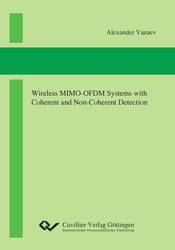| Areas | |
|---|---|
| Serie de libros (96) |
1379
|
| Nachhaltigkeit |
3
|
| Gesundheitswesen |
1
|
| Letra |
2367
|
| Ciencias Naturales |
5407
|
| Ciencias Ingeniería |
1793
|
| Ingeniería | 292 |
| Ingeniería mecánica y de proceso | 862 |
| Ingeniería eléctrica | 686 |
| Mineria y metalurgía | 30 |
| Arquitectura e ingeniería civil | 75 |
| General |
98
|
|
Leitlinien Unfallchirurgie
5. Auflage bestellen |
|
Erweiterte Suche
Wireless MIMO-OFDM Systems with Coherent and Non-Coherent Detection (Tienda española)
Alexander Vanaev (Autor)Previo
Lectura de prueba, PDF (160 KB)
Indice, PDF (57 KB)
In this thesis the physical layer design of broadband MIMO-OFDM communication systems is considered taking into account the realistic multipath radio channel. The main focus is made on examining a number of coherent and non-coherent MIMO techniques both analytically and via computer simulations. Several proposals are made to assist intelligent selection of MIMO precoding and decoding algorithms. Additionally two novel improved differential transmission schemes are presented and analyzed.
In dieser Arbeit wird der Entwurf der physikalischen Schicht für breitbandige MIMO-OFDM Kommunikationssysteme betrachtet. Dazu werden realistische Funkkanalmodelle mit Mehrwegeausbreitung berücksichtigt. Ein wesentlicher Schwerpunkt der Arbeit liegt auf Untersuchungen zu kohärenten und nichtkohärenten MIMO-Techniken, die sowohl analytisch als auch mit Hilfe von Computersimulationen durchgeführt werden. Es werden verschiedene Vorschläge erarbeitet, wie eine intelligente Auswahl von MIMO-Techniken zur Vorcodierung sowie zur Decodierung getroffen werden kann. Darüber hinaus werden zwei neuartige, verbesserte differentielle Übertragungsverfahren vorgestellt und analysiert.
| ISBN-13 (Impresion) | 9783954043422 |
| ISBN-13 (E-Book) | 9783736943421 |
| Formato | A5 |
| Idioma | Inglés |
| Numero de paginas | 206 |
| Laminacion de la cubierta | mate |
| Edicion | 1. Aufl. |
| Lugar de publicacion | Göttingen |
| Lugar de la disertacion | Hamburg-Harburg |
| Fecha de publicacion | 05.02.2013 |
| Clasificacion simple | Tesis doctoral |
| Area |
Ingeniería eléctrica
|
| Palabras claves | Nachrichten- und Kommunikationstechnik, MIMO, OFDM, STBC, Spatial Multiplexing, Differential Space-Time Block Code, DAPSK |








